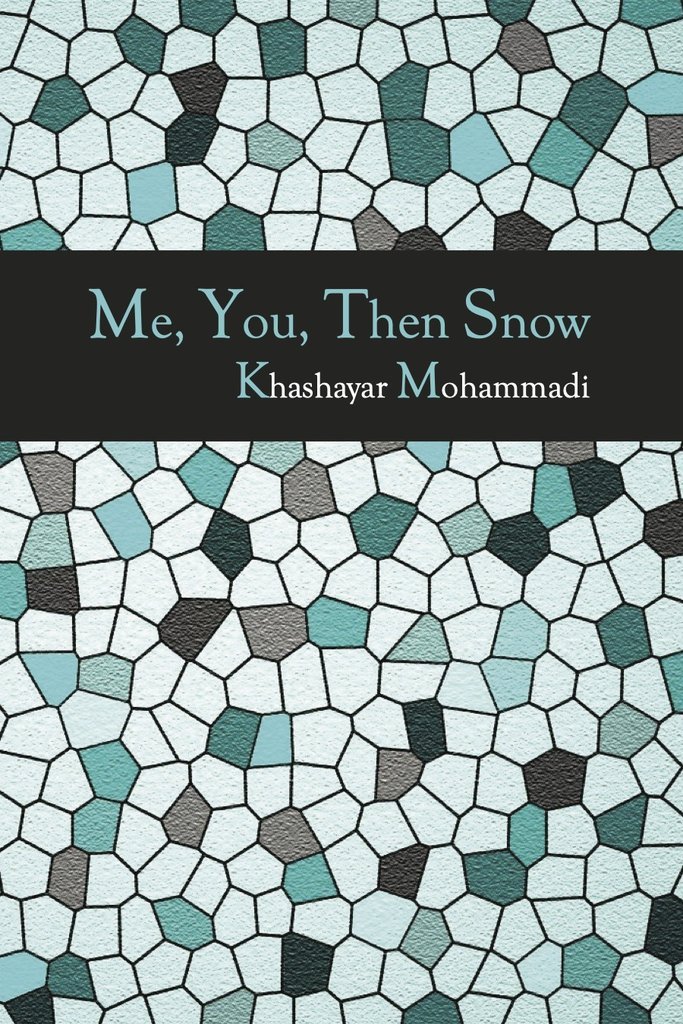Looking Three Ways in 'Me, You, Then Snow'
Much like its title, the poems in Khashayar Mohammadi’s debut poetry collection, Me, You, Then Snow, drift between intimate relationality and the imagistic, which often emerge by way of surprising turns. Intimacy between two figures, or a self confronting itself as a self, regularly includes a tertiary figure, element, image, scene, or landscape that bursts out of bodies, phrases, or thoughts.
Recognizable scenes transform into unrecognizable ones—into the fantastic or the ethereal: “skin” is “abstracted / into music” or someone is “peel[ed] … off into a constellation.” Likewise,
A tame moment of compassion morphed into a wolf pack in your eye.
I stretched for your smile, but you balled up into a mountain. Reciting
Premeditated thoughts of comfort, I ran out of words.My head cradled sunlight to its resting place. Did you ever have a face?
Me, You, Then Snow takes up this question of face as a perennial one. Do we know our lovers if so much face can be abstracted into beauty? Can we touch such beauty? Do we know the beauty of our own face in the look of another’s transmogrifying eye? To that end, the book offers an erotics of cinema in the language of poetry. The poems in this collection move between amatory scenes to meditative ones—to cityscapes and desirescapes. Mohammadi illuminates that psychic webbing that undergirds our relational selves.
As a whole, the collection is also adrift, wavering between proximate fragmentary structures and scopes. Its references to experimental cinema—such as the work of Michael Haneke, Wong Kar Wai, and Ingmar Bergman—can help orient readers familiar with them towards an analogous sense of drifting, voyeurism, and duration of which they are known for.
Wong Kar Wai’s In the Mood for Love (2000), for instance, revolves around two neighbours who suspect their respective partners are having an affair and decide to re-enact what is possibly transpiring between them by going through the motions of being lovers with each other. What the lovers attempt to move towards is the experience of looking at and inhabiting an amatory secret that is outside of them—near, yet foreclosed. Mohammadi’s collection similarly enacts such gestures of movement, glancing, furtiveness, and compassionate suspicion.
Formally, Mohammadi often uses mirrored forms and repetitions to suture poems together. These recurrences are never forced or clunky; rather, they allow one to steep in the vibratory matter of the work. This motif is taken up in the question of language itself, such as in “Odourless Poem”:
boo is smell
but boo is also in boodan
which is “to be”like the phrase
be toe boodan
“to be without you”
but the persian be
means without
be toe
“without you”the boo in boodan
akin to english Beto be
but the persian to
means “Inside” or “In”
and the persian In
means “this”to be
is illegible
but be-to
means “No Insides” or “empty”to be be-to
to be “empty” “endless”
It is this strange quality of alienation that pulses through Mohammadi’s collection. The images are confounding and beautiful, leaving one to wonder where the dreaming begins in this book—or if it is even a question of dreaming, but looking, of attentiveness. The book’s epigraph by Hossein Panahi speaks directly to this tertiary, spectral quality: “Alas!, who was the third one weeping? I thought we were only two.”
Me, You, Then Snow explores what is auxiliary to intimate experience but never as lesser forms of experience that intercede relationality—that disturb, perturb, and augment experience itself when we take the time to look.
Prathna Lor
Prathna Lor, the poetry editor of Shrapnel, is a poet, essayist, and educator currently living in Tiohtià:ke (Montréal). Their writing has appeared in DIAGRAM, C Magazine, Jacket2, and Canadian Literature, among other places.



